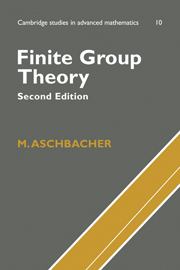Book contents
- Frontmatter
- Contents
- Preface
- 1 Preliminary results
- 2 Permutation representations
- 3 Representations of groups on groups
- 4 Linear representations
- 5 Permutation groups
- 6 Extensions of groups and modules
- 7 Spaces with forms
- 8 p-groups
- 9 Change of field of a linear representation
- 10 Presentations of groups
- 11 The generalized Fitting subgroup
- 12 Linear representations of finite groups
- 13 Transfer and fusion
- 14 The geometry of groups of Lie type
- 15 Signalizer functors
- 16 Finite simple groups
- Appendix
- References
- List of Symbols
- Index
12 - Linear representations of finite groups
Published online by Cambridge University Press: 05 June 2012
- Frontmatter
- Contents
- Preface
- 1 Preliminary results
- 2 Permutation representations
- 3 Representations of groups on groups
- 4 Linear representations
- 5 Permutation groups
- 6 Extensions of groups and modules
- 7 Spaces with forms
- 8 p-groups
- 9 Change of field of a linear representation
- 10 Presentations of groups
- 11 The generalized Fitting subgroup
- 12 Linear representations of finite groups
- 13 Transfer and fusion
- 14 The geometry of groups of Lie type
- 15 Signalizer functors
- 16 Finite simple groups
- Appendix
- References
- List of Symbols
- Index
Summary
Chapter 12 considers FG-representations where G is a finite group, F is a splitting field for G, and the characteristic of F does not divide the order of G. Under these hypotheses, FG-representation theory goes particularly smoothly. For example Maschke's Theorem says each FG-representation is the sum of irreducibles, while, as F is a splitting field for G, each irreducible FG-representation is absolutely irreducible.
Section 34 begins the analysis of the characters of such representations. We find that, if m is the number of conjugacy classes of G, then G has exactly m irreducible characters (χi: 1 ≤ i < m), and that these characters form a basis for the space of class functions from G into F.
A result of Brauer (which is beyond the scope of this book) shows that, under the hypothesis of the first paragraph, the representation theory of G over F is equivalent to the theory of G over ℂ, so section 35 specializes to the case F = ℂ. The character table of G over ℂ is defined; this is the m by m complex matrix (χi(gj)), where (gj 1 ≤ j ≤ m) is a set of representatives for the conjugacy classes of G. Various numerical relations on the character table are established; among these the orthogonality relations of lemma 35.5 are most fundamental. The concepts of induced representations and induced characters are also discussed.
- Type
- Chapter
- Information
- Finite Group Theory , pp. 177 - 196Publisher: Cambridge University PressPrint publication year: 2000
- 1
- Cited by

